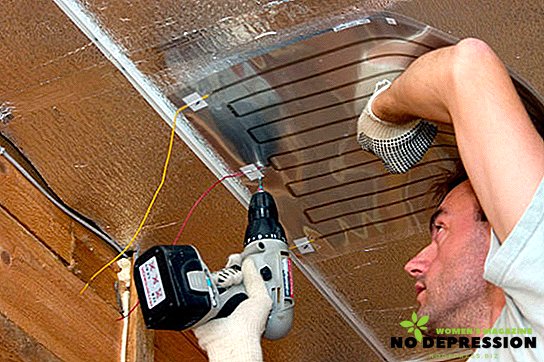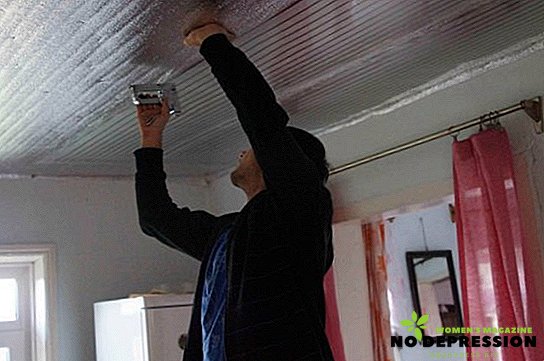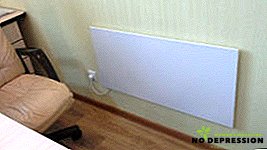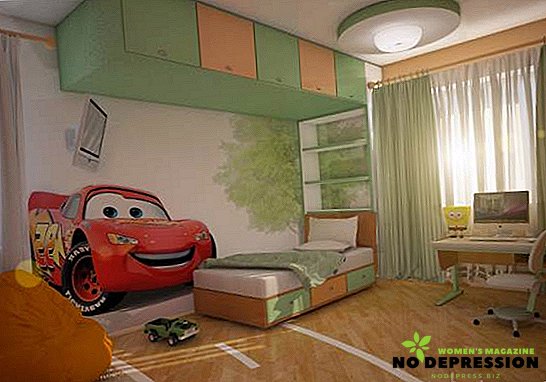Infrared heating at home - a modern heating system, which has many advantages. However, in order for such a construction to work properly, to please the heat and not to cause harm, it is necessary to choose the heater correctly and install it.

Infrared heating: history and properties
Despite the perception of this type of heating as a novelty, infrared rays have been used for many years. At the beginning of the 19th century, the infrared range of the light beam was discovered by William Herschel, and in the 20th century, the famous automaker Henry Ford found advantageous use of this discovery.
He used the radiation to dry the car after painting. In the middle of the 60s of the 20th century, the predecessors of modern versions of infrared heating devices appeared. They were created in Switzerland and demonstrated all the benefits of infrared heating. Only a few decades ago, entrepreneurs paid attention to the possibility of using such radiation for space heating.
Infrared properties
Scientists, based on the principles of solar heating, created the first infrared heater. It is important that they have reached the possibility of eliminating the intermediate environment during the transfer of heat from the source to the consumer, which made it possible to significantly reduce the power indices. This reduced the energy consumed by the heaters.
 Thus, they do not warm the air, but people, things, furniture. Objects, being subjected to heat treatment, transfer the accumulated heat to the air. This increases the period of comfortable stay in the room where such heaters are installed. Due to this, there is no need for a powerful source of heat, which previously had to first heat a large amount of air in the room.
Thus, they do not warm the air, but people, things, furniture. Objects, being subjected to heat treatment, transfer the accumulated heat to the air. This increases the period of comfortable stay in the room where such heaters are installed. Due to this, there is no need for a powerful source of heat, which previously had to first heat a large amount of air in the room.
To ensure the effectiveness of infrared heating with minimal power consumption, you just need to compare the characteristics of this equipment and electrical appliances. So, for heating a room of 20 sq.m. using infrared heat source will need 1100 watts of power. To heat this space with electric heaters, a minimum power of 2 kW is required.
The principle of infrared heating
Every year this type of heating is spreading more and more in the world, occupying a leading position as a worthy alternative to the usual heaters. All IR devices operate as follows:
- The equipment is connected to the network 220 V.
- There is heating TENA.
- From TENA heat is directed to a special heat radiating plate.
- Infrared radiation forms from the plate.
This heating system differs from the traditional one in that it first warms up the objects located in the room, and the air already gets warm from them. This process is effective in that the air rises as it warms up, due to which the heat spreads evenly around the room. Living organisms on the infrared heat reacts differently.
Due to the fact that such heating affects the peripheral circulatory system, a feeling of comfort with such heating occurs at a temperature 2-3 degrees lower than when exposed to normal heat. Due to this, the device can not be turned on at full capacity, which saves energy.
Pros and cons of infrared heating at home
Let us examine the pros and cons of such heating in terms of comfort and favorable heat supply, as well as its effects on the human body. First of all, it should be taken into account that such heating does not burn the oxygen content, and due to its use it is possible to keep the humidity of the air. The correct location of the system, the appropriate choice of equipment can achieve the necessary heating and temperature conditions in the area of rest and residence.
pros
For home, the most effective are ceiling and wall types of heaters. First of all, because they are easy to install. Most often use a warm floor with infrared elements that are mounted under all types of flooring. The main benefits include:
- fast warming up of the room;
- high resistance to power surges, which is very important for the private sector;
- devices do not dry the air;
- ease of installation, as it does not need special skills and tools;

- profitability.
Minuses
For example, the complexity of combining ceiling with the style of the interior. Thus, they are not suitable for mounting in rooms where a classical style has been chosen. And also it is necessary to pre-design the heating system so that the heat is properly distributed around the room. Moreover, the disadvantages are quite high prices of this equipment.
Good or bad?
Many wonder if infrared heating will be dangerous to humans. After all, it is a radiation, and this word itself causes concern. Infrared radiation is a major part of sunlight. Everyone knows that if you follow the usual rules for being in the sun, it is completely harmless. So the heating of this type will be safe while observing the basic rules of operation.
In the very heating of this type there are no harmful chemical reactions, no elements that can cause vibration or noise. These are signs not only of high environmental friendliness, but also of harmlessness to humans. In infrared heating apply the safest wavelength for humans. However, it is impossible to say that infrared heating is 100% safe. Damage may be caused by non-observance of the basic rules for the use of equipment, its incorrect placement. As a result of such violations may be the following negative consequences:
- Overheat. If you install a heater, which is several times greater than the power sufficient for this room.
- Overdrying of the skin, if a person’s position does not change for a long time, the heater affects only one side of the body.
- Often the harm of such heating manifests itself when the installation location was chosen incorrectly, for example, you bought a ceiling option and placed heating in a recreation area, namely in the head area. Exposure in this case can cause severe headache.
- Excessive power can also cause damage to body cells.
In order for these devices not to cause harm, it is necessary to correctly select the equipment parameters, to comply with all technical requirements for its installation and further operation.
Varieties of infrared heaters
IR heaters can be made in panel and film versions. Panel variation is used to create a specific recreation area. It can be used for both ceiling and wall and flooring. True for such heating structures stretch ceilings are not suitable.
The basis of film heaters are usually made up of thin layers of graphite or carbon filament, which are parallel to each other. This type of heaters fits perfectly into the interior, can be used as a local heating device in a designated area.
The principle of operation of film heaters is to accept heat from the heating element on special panels. They can be made of various materials, for example from gypsum board, glass, plastic.
The modern market is a huge number of infrared heaters, differing in the method of arrangement of elements. They are usually divided:
 Outdoor. Inside such devices are mounted flat heating discs. The coating of this type is sold in rolls. In the process of mounting it is cut into pieces of the desired size. Such modular materials when laying on the floor require compliance with the distance between the parts in the region of 15 cm. They are also contraindicated to place overlap. They can be decorated using laminate, carpet or other type of coating.
Outdoor. Inside such devices are mounted flat heating discs. The coating of this type is sold in rolls. In the process of mounting it is cut into pieces of the desired size. Such modular materials when laying on the floor require compliance with the distance between the parts in the region of 15 cm. They are also contraindicated to place overlap. They can be decorated using laminate, carpet or other type of coating.- Wall mounted. The main condition for operation is location on the wall. The main thing is that the panels should be installed above or below the head of the residents. When using a wall-mounted infrared heater, it is not recommended to install it in local recreation areas in order to avoid various uncomfortable situations.
- Ceiling. Such emitters are suitable for installation in suspended ceilings. They are usually placed at a height of about 3 m. Due to the design of devices of this type, the floor is first heated by them. It is not recommended to place ceiling emitters near windows and doors in order to avoid significant heat losses.
Tips for choosing
The choice of heater depends primarily on the size of the room. Before purchasing, you must first decide which device you need: it can be stationary or portable. Heaters of the second type are characterized by low power and size, but at the same time they are mobile and practical. Stationary models are mounted in the walls, ceiling, under the flooring.
For example, quartz heaters are not recommended for people who suffer from allergies or asthma, in addition, such devices irritate eyesight. Good reviews about appliances with a ceramic heating element. In the process, there is no light, in addition, such heating equipment is considered the most economical, it can serve more than 3 years. The main disadvantage is the relatively high cost.
When buying an infrared heater, ask the thickness of the layer that covers the plate and is responsible for the emission of infrared waves. The quality indicator is a thickness of more than 25 microns.
This will indicate that the period of use of such a device may be more than 20 years. Still, experts recommend finding out how thick the emitter foil is. In reliable devices, this figure exceeds 120 microns. Be sure to pay attention to power. This indicator goes in the ratio of 1 to 10, that is, per 10 square meters the power is 1 kW.
Major manufacturers
The most popular models of heaters from the following manufacturers: Ekostar, Teplov, UFO, Thermoplaza, Bilyuks, Timberk, Ballu.
The Ekostar infrared system is designed for use in rooms of various sizes. Models for industrial premises can heat shops, technical centers. The advantages of such products include efficiency, reliability, long operating life, which reaches 25 years. The manufacturer sells ceiling, wall, floor heaters. They are distinguished by ease of installation, cost-effectiveness, and the absence of harmful radiations.
UFO heaters are popular in 20 countries. Due to the special moisture-proof housing, this technique can be installed in rooms with high humidity. In case of overheating, such a device switches off, which allows to reduce the electrical load and to insure itself against ignition.

The equipment from Thermoplase does not emit any noise during operation, and it functions on the basis of two heating principles: infrared and convection. Installation of such equipment can be done personally.
The infrared heater of the Ukrainian manufacturer Bilyuks is supplemented with reliable thermal insulation, which guarantees non-flammability even when high temperature is reached. They are considered the safest devices.
The Swiss company Timberk describes its products as popular and complies with European quality standards.
The international company Ballu manufactures and sells household and heating appliances, including infrared heaters. They can be used both for industrial applications and for providing heat in small apartments.
Installation features
As practice shows, even a beginner can handle installing this type of heating system. Installation itself does not take much time and is considered very simple. At the initial stage it is important to choose the right place for installation. It is worth considering that such products should not be placed:
- in places that are close to other electrical equipment;
- near the overall furniture;
- near doors and windows.
Installation of devices occurs in several stages. At the beginning of work it is necessary to fix the brackets with self-tapping screws and install the panel. In the process of doing the work you will need: a tape measure, a pencil, pliers, screwdrivers, screwdrivers. Having installed infrared equipment, it is necessary to bring it to the thermostat and connect it to the network. To do this, do not do without a three-core cable, parts of which are connected to the terminals according to the indicated polarity. And before turning on the device panel is recommended to wipe with an alcohol solution.



 Outdoor. Inside such devices are mounted flat heating discs. The coating of this type is sold in rolls. In the process of mounting it is cut into pieces of the desired size. Such modular materials when laying on the floor require compliance with the distance between the parts in the region of 15 cm. They are also contraindicated to place overlap. They can be decorated using laminate, carpet or other type of coating.
Outdoor. Inside such devices are mounted flat heating discs. The coating of this type is sold in rolls. In the process of mounting it is cut into pieces of the desired size. Such modular materials when laying on the floor require compliance with the distance between the parts in the region of 15 cm. They are also contraindicated to place overlap. They can be decorated using laminate, carpet or other type of coating.









